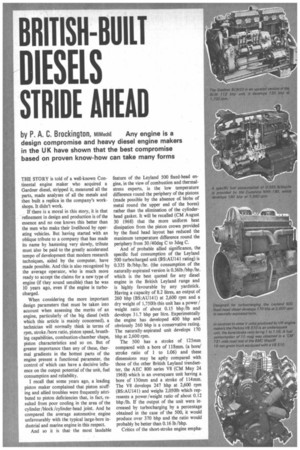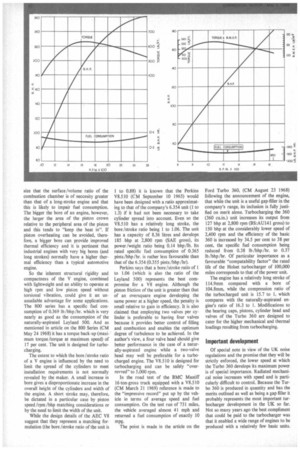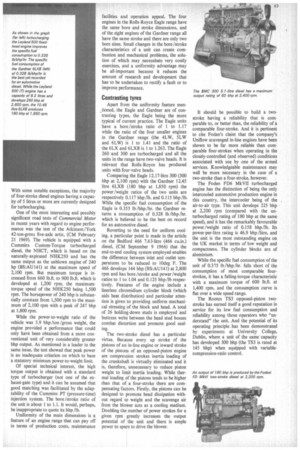BRITISH-BUILT
Page 62

Page 64

Page 65

If you've noticed an error in this article please click here to report it so we can fix it.
DIESELS
STRIDE AHEAD
by P. A. C. Brockington, M1MechE Any engine is a
design compromise and heavy diesel engine makers in the UK have shown that the best compromise based on proven know-how can take many forms
THE STORY is told of a well-known Continental engine maker who acquired a Gardner diesel, stripped it. measured all the parts, made analyses of all the metals and then built a replica in the company's workshops. It didn't work.
If there is a moral in this story, it is that refinement in design and production is of the essence and no one knows this better than the men who make their livelihood by operating vehicles. But having started with an oblique tribute to a company that has made its name by hastening very slowly, tribute must also be paid to the greatly accelerated tempo of development that modern research techniques, aided by the computer, have made possible. And this is also recognized by the average operator, who is much more ready to accept the claims for a new type of engine (if they sound sensible) than he was 10 years ago, even if the engine is turbocharged.
When considering the more important design parameters that must be taken into account when assessing the merits of an engine, particularly of the big diesel (with which this article is mainly concerned), a technician will normally think in terms of rpm, stroke /bore ratio, piston speed, breathing capabilities, combustion-chamber shape, piston characteristics and so on. But of greater importance than any of these, thermal gradients in the hottest parts of the engine present a functional parameter, the control of which can have a decisive influence on the output potential of the unit, fuel consumption and reliability.
I recall that some years ago, a leading piston maker complained that piston scuffing and allied troubles were frequently attributed to piston deficiencies that, in fact, resulted from poor cooling in the area of the cylinder /block /cylinder-head joint. And he compared the average automotive engine unfavourably with the typical large-bore industrial and marine engine in this respect.
And so it is that the most laudable feature of the Leyland 500 fixed-head engine, in the view of combustion and thermalstress experts, is the low temperature difference round the periphery of the pistons (made possible by the absence of blobs of metal round the upper end of the bores) rather than the elimination of the cylinderhead gasket. It will be recalled (CM August 30 1968) that the more uniform heat dissipation from the piston crown provided by the fixed head layout has reduced the maximum temperature difference round the periphery from 30 /40deg C to 3deg C.
And of probable allied significance, the specific fuel consumption of the Leyland 500 turbocharged unit (BS:AU141 rating) is 0.335 lb/bhp/hr. (the consumption of the naturally-aspirated version is 0.361b /bhp /hr. which is the best quoted for any diesel engine in the British Leyland range and is highly favourable by any yardstick. Having a capacity of 8.2 litres, an output of 260 bhp (BS:AU141) at 2,600 rpm and a dry weight of 1,7501b this unit has a power / weight ratio of about 0.15 bhp /lb and develops 31.7 bhp per litre. Experimentally the engine has developed 400 bhp and obviously 260 bhp is a conservative rating. The naturally-aspirated unit develops 170 bhp at 2,600 rpm.
The 500 has a stroke of 125mm compared with a bore of 118mm. (a bore/ stroke ratio of 1 to 1.06) and these dimensions may be aptly compared with those of the other British Leyland trendsetter. the AEC 800 series V8 (CM May 24 1968) which is an oyersquare unit having a bore of 130mm and a stroke of 114mm. The V8 develops 247 bhp at 2,600 rpm (BS:AU141) and weighs 2,0501b which represents a power /weight ratio of about 0.12 bhp /lb. If the output of the unit were increased by turbocharging by a percentage obtained in the case of the 500, it would produce over 370 bhp and the ratio would probably be better than 0.16 lb /bhp.
Critics of the short-stroke engine empha
size that the surface/volume ratio of the combustion chamber is of neccesity greater than that of a long-stroke engine and that this is likely to impair fuel consumption. The bigger the bore of an engine, however, the larger the area of the piston crown relative to the peripheral area of the piston and this tends to "keep the heat in". If piston overheating can be avoided, therefore, a bigger bore can provide improved thermal efficiency and it is pertinent that industrial engines with very big bores (and long strokes) normally have a higher thermal efficiency than a typical automotive engine.
So the inherent structural rigidity and compactness of the V engine, combined with lightweight and an ability to operate at high rpm and low piston speed without torsional vibration, could give it an unassailable advantage for some applications. The 800 series has a specific fuel consumption of 0.369 lb/bhp/hr. which is very nearly as good as the consumption of the naturally-aspirated Leyland 500. And as mentioned in article on the 800 Series (CM May 24 1968) it has a torque back-up (maximum torque/torque at maximum speed) of 17 per cent The unit is designed for turbocharging.
The extent to which the bore/stroke ratio of a V engine is influenced by the need to limit the spread of the cylinders to meet installation requirements is not normally revealed by the maker. A small increase in bore gives a disproportionate increase in the overall height of the cylinders and width of the engine. A short stroke may, therefore, be dictated in a particular case by piston speed /rpm /bhp matching considerations or by the need to limit the width of the unit.
While the design details of the AEC V8 suggest that they represent a matching formulation (the bore /stroke ratio of the unit is 1 to 0.88) it is known that the Perkins V8.510 (CM September 10 1965) would have been designed with a ratio approximating to that of the company's 6.354 unit (I to L3) if it had not been necessary to take cylinder spread into account. Even so the V8.510 has a relatively long stroke, the bore /stroke ratio being 1 to 1.06. The unit has a capacity of 8.36 litres and develops 185 bhp at 2,800 rpm (SAE gross), its power /weight ratio being 0.14 bhp /lb. Its rated specific fuel consumption of 0.365 pints /bhp /hr. is rather less favourable than that of the 6.354 (0.355 pints /bhp /hr).
Perkins says that a bore /stroke ratio of 1 to 1.06 (which is also the ratio of the Leyland 500) represents the best compromise for a V8 engine. Although the piston friction of the unit is greater than that of an oversquare engine developing the same power at a higher speed, the penalty is small relative to gain in efficiency. It is also claimed that employing two valves per cylinder is preferable to having four valves because it provides better control of filling and combustion and enables the optimum degree of turbulence to be achieved. In the author's view, a four valve head should give better performance in the case of a naturally-aspirated engine while a two-valve head may well be preferable for a turbocharged engine. The V8.510 is designed for turbocharging and can be safely "overrevved" to 5,000 rpm.
In the road test of the BMC Mastiff 16-ton-gross truck equipped with a V8.510 (CM March 21 1969) reference is made to the "impressive record" put up by the vehicle in terms of average speed and fuel consumption. On the test run of 731 miles, the vehicle averaged almost 41 mph and returned a fuel consumption of exactly 10 mpg.
The point is made in the article on the Ford Turbo 360, (CM August 23 1968) following the announcement of the engine, that while the unit is a useful gap-filler in the company's range, its inclusion is fully justified on merit alone. Turbocharging the 360 (360 min.) unit increases its output from 127 bhp at 2,800 rpm (BS:AU141 gross) to 150 bhp at the considerably lower speed of 2,400 rpm and the efficiency of the basic 360 is increased by 34.5 per cent to 38 per cent, the specific fuel consumption being reduced from 0.38 lb /bhp /hr. to 0.37 lb /bhp/hr. Of particular importance as a favourable "compatability factor" the rated life of the Holset turbocharger of 100,000 miles corresponds to that of the power unit.
The engine has a relatively long stroke of 114.9mm compared with a bore of I04.8mm, while the compression ratio of the turbocharged unit is 15.7 to 1, which compares with the naturally-aspirated engine's ratio of 16.3 to 1. Modifications to the bearing caps, pistons, cylinder head and valves of the Turbo 360 are designed to cater for the higher mechanical and thermal loadings resulting from turbocharging.
Important development Of special note in view of the UK noise regulations and the promise that they will be strictly enforced, the lower speed at which the Turbo 360 develops its maximum power is of special importance. Radiated mechanical noise increases with speed and is particularly difficult to control. Because the Turbo 360 is produced in quantity and has the merits outlined as well as being a gap filler it probably represents the most important turbocharger development in the UK so far. Not so many years ago the best compliment that could be paid to the turbocharger was that it enabled a wide range of engines to be produced with a relatively few basic units. With some notable exceptions, the majority of four-stroke diesel engines having a capacity of 5 litres or more are currently designed for turbocharging.
One of the most interesting and possibly significant road tests of Commercial Motor in recent years with regard to engine performance was the test of the Atkinson/York 42-ton-gross five-axle artic, (CM February 21 1969). The vehicle is equipped with a Cummins Custom-Torque turbocharged diesel, the NHCT, which is based on the naturally-aspirated NHK250 and has the same output as the unblown engine of 240 hp (BS:AU141) at the maximum speed of 2,100 rpm. But maximum torque is increased from 660 lb.ft. to 900 lb.ft. which is developed at 1,200 rpm, the maximumtorque speed of the NHK250 being 1,500 rpm. The horsepower of 240 bhp is substantially constant from 1,500 rpm to the maximum of 2,100 rpm with a peak Of 247 bhp at 1,800 rpm.
While the power-to-weight ratio of the vehicle was 5.9 bhp /ton /gross weight, the engine provided a performance that could only have been obtained from a more conventional unit of very considerably greater bhp output. As mentioned in a leader in the same issue, the test showed that peak power is an inadequate criterion on which to base a statutory minimum power-to-weight limit.
Of special technical interest, the high torque output is obtained with a standard type of turbocharger (not one of the exhaust-gate type) and it can be assumed that good matching was facilitated by the adaptability of the Cummins PT (pressure-time) injection system. The bore /stroke ratio of the unit is about 1 to 1.1. It would, perhaps, be inappropriate to quote its bhp/lb.
Uniformity of the main dimensions is a feature of an engine range that can pay off in terms of production costs, maintenance facilities and operation appeal. The four engines in the Rolls-Royce Eagle range have the same bore and stroke dimensions, and of the eight engines of the Gardner range all have the same stroke and there are only two bore sizes. Small changes in the bore /stroke characteristics of a unit can create combustion and mechanical problems, the solution of which may necessitate very costly exercises, and a uniformity advantage may be all-important because it reduces the amount of research and development that has to be undertaken to rectify a fault or to improve performance.
Contrasting tyres
Apart from the uniformity feature mentioned, the Eagle and Gardner are of contrasting types, the Eagle being the more typical of current practice. The Eagle units have a bore /stroke ratio of 1 to 1.17 while the ratio of the four smaller engines in the Gardner range (the 41W, 5LW and 6LW) is 1 to 1.41 and the ratio of the 6LX and 6LXB is 1 to 1.263. The Eagle 260 and 300 are turbocharged and all the units in the range have two-valve heads. It is relevant that Rolls-Royce has produced units with four-valve heads.
Comparing the Eagle 12.17-litre 300(300 bhp at 2,100 rpm) with the Gardner 12.45 litre 6LXB (180 bhp at 1,850 rpm) the power /weight ratios of the two units are respectively 0.117 bhp/lb. and 0.115 bhp /lb. While the specific fuel consumption of the Eagle is 0.355 lb /bhp/hr. the Gardner returns a consumption of 0.328 lb/bhp /hr. which is believed to be the best on record for an automotive diesel.
Reverting to the need for uniform cooling, a particular point is made in the article on the Bedford 466 7.63-litre (466 cu.in.) diesel, (CM September 9 1966) that the end-to-end cooling system employed enables the difference between inlet and outlet temperatures to be reduced to 10deg F. The 466 develops 144 bhp (BS:AU141) at 2,800 rpm and has bore /stroke and power /weight ratios to 1 to 1.04 and 0.125 bhp fib respectively. Features of the engine include a linerless chromidium cylinder block (which aids heat distribution) and particular attention is given to providing uniform mechanical stressing of the block and head. A total of 26 holding-down studs is employed and buttress webs between the head stud bosses combat distortion and promote good sealing.
The two-stroke diesel has a particular virtue. Because every up stroke of the pistons of an in-line engine or inward stroke of the pistons of an opposed-piston engine are compression strokes inertia loading of the crankshaft is virtually eliminated and it is, therefore, unnecessary to reduce piston weight to limit inertia loading. While thermal loading of the pistons tends to be higher than that of a four-stroke there are compensating factors. Firstly, the pistons can be designed to promote head dissipation without regard to weight and the scavenge air from the blower acts as a cooling medium. Doubling the number of power strokes for a given rpm greatly increases the output potential of the unit and there is ample power to spare to drive the blower. It should be possible to build a twostroke having a reliability that is comparable to, or better than, the reliability of a comparable four-stroke. And it is pertinent to cite Foden's claim that the company's Uniflow scavenged in-line engines have been shown to be far more reliable than comparable four-strokes when operating in the closely-controlled (and observed) conditions associated with use by one of the armed services. Knowledgeable maintenance may well be more necessary in the case of a two-stroke than a four-stroke, however.
The Foden FD6 MkVII turbocharged engine has the distinction of being the only intercooled automotive production engine in this country, the intercooler being of the air-to-air type. This unit develops 225 bhp at 2,200 rpm (compared with the unturbocharged rating of 180 bhp at the same speed), and it has the remarkably favourable power /weight ratio of 0.158 bhp /lb. Its power-per-litre rating is 46.9 bhp /litre, and the unit is the most outstanding engine on the UK market in terms of low weight and compactness. The cylinder blocks are of aluminium.
While the specific fuel consumption of the unit of 0.375 lb/bhp/hr. falls short of the consumption of most comparable fourstrokes, it has a falling-torque characteristic with a maximum torque of 600 lb.ft. at 1,400 rpm, and the consumption curve is flat over a wide speed range.
The Rootes TS3 opposed-piston twostroke has earned itself a good reputation in service for its low fuel consumption and reliability among those operators who "understand" the unit. And the potential of its operating principle, has been demonstrated by experiments at University College, Dublin, where a unit of the same capacity has developed 300 bhp (the TS3 is rated at 145 bhp) when equipped with variablecompression-ratio control.




















































































































































































































